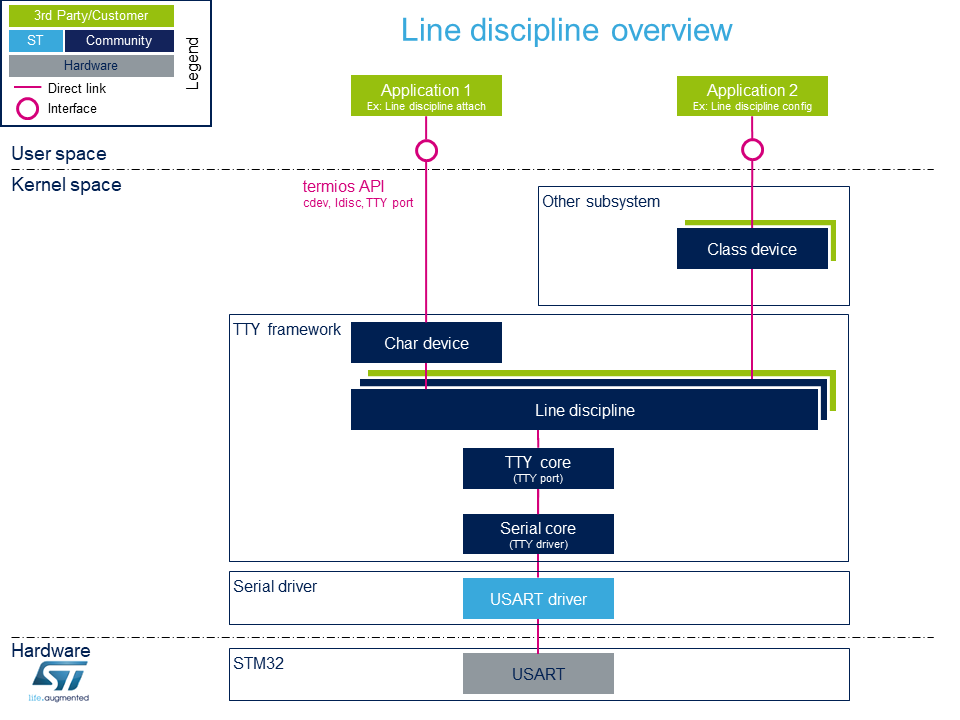“Serial TTY line discipline”的版本间的差异
Zhouyuebiao(讨论 | 贡献) |
|||
| 第1行: | 第1行: | ||
| − | + | 本文提供有关 Linux® TTY 框架的信息。 它说明了如何使用线路规则激活“ UART”接口,以及如何从用户和内核空间访问它。<br /> | |
==Framework purpose== | ==Framework purpose== | ||
2020年11月9日 (一) 10:38的版本
本文提供有关 Linux® TTY 框架的信息。 它说明了如何使用线路规则激活“ UART”接口,以及如何从用户和内核空间访问它。
目录
Framework purpose
UART is a common interface for several device types, such as Bluetooth, NFC, FM Radio and GPS devices.
Since kernel version 4.12, the serial device bus (also called Serdev) has been introduced in the TTY framework to improve the interface offered to devices attached to a serial port. Please refer to the Serial TTY overview article for a detailed description of the TTY framework purpose. Nevertheless it's still possible (even if not recommended) to use line disciplines "drivers".
This article focuses on the line discipline interface offered to devices attached to a serial port.
<securetransclude src="ProtectedTemplate:ReviewsComments" params="FGA W1941: I just reworked that a little. please check."></securetransclude>{{#set:Has reviews comments=true}}
System overview

Components description
From client application to hardware
- Application: customer application to read/write data from the peripheral connected on the serial port.
- TTY tools: tools provided by Linux community, such as stty, ldattach, inputattach, tty, ttys, agetty, mingetty, kermit and minicom.
<securetransclude src="ProtectedTemplate:ReviewsComments" params="FGA W1941: I can't find TTY tools in above figure. Is it relevant here?."></securetransclude>{{#set:Has reviews comments=true}}
- Termios: API[1] which offers an interface to develop an application using serial drivers.
- Client subsystem: kernel subsystem client of TTY core (Example: a Bluetooth device)
<securetransclude src="ProtectedTemplate:ReviewsComments" params="FGA W1941: I can't find "Client subsystem" in above figure."></securetransclude>{{#set:Has reviews comments=true}}
- TTY framework: high-level TTY structures management, including drivers/tty/tty_io.c | |}} tty character device driver , drivers/tty | |}} TTY core functions , line discipline.
<securetransclude src="ProtectedTemplate:ReviewsComments" params="FGA W1941: "TTY framework" -> "TTY Core" in above figure ?"></securetransclude>{{#set:Has reviews comments=true}}
- Serial framework: low-level serial driver management, including the drivers/tty/serial/serial_core.c | |}} serial core functions .
<securetransclude src="ProtectedTemplate:ReviewsComments" params="FGA W1941: "Serial framework" -> "Serial Core" in above figure ?"></securetransclude>{{#set:Has reviews comments=true}}
- USART driver: drivers/tty/serial/stm32-usart.c | |}} stm32-usart low-level serial driver for all stm32 family devices.
- STM32 USART: STM32 frontend IP connected to the external devices through a serial port
<securetransclude src="ProtectedTemplate:ReviewsComments" params="FGA W1941: Maybe worth adding the external device in the above figure ?"></securetransclude>{{#set:Has reviews comments=true}}
APIs description
The TTY provides only character device interface (named /dev/ttyX) to user space.
The main API for user space TTY client applications is provided by the portable POSIX terminal interface termios, which relies on /dev/ttyX interface for TTY link configuration.
The termios API[1] is a user land API, and its functions describe a general terminal interface that is provided to control asynchronous communications ports.
The POSIX termios API abstracts the low-level details of the hardware, and provides a simple yet complete programming interface that can be used for advanced projects. It is a wrapper on character device API [2] ioctl operations.
| A line discipline driver can be used when a serial interface is needed at kernel level. |
For example, a kernel driver maybe needed to control an external device through an U(S)ART port. <securetransclude src="ProtectedTemplate:ReviewsComments" params="FGA W1941: I rephrased above note, can you please double-ckeck ?"></securetransclude>{{#set:Has reviews comments=true}}
- The line discipline will be responsible for:
- creating this new kernel API
- routing data flow between serial core and new kernel API
<securetransclude src="ProtectedTemplate:ReviewsComments" params="FGA W1941: No how to use section, nor examples ? Is it deliberate ?<br/> FGA W1941: Maybe worth pointing out some existing examples in the kernel ?"></securetransclude>{{#set:Has reviews comments=true}}
References
- ↑ 1.01.1 termios API, Linux Programmer's Manual termios API Documentation (user land API with serial devices)
- ↑ Character device API overview, Accessing hardware from userspace training, Bootlin documentation